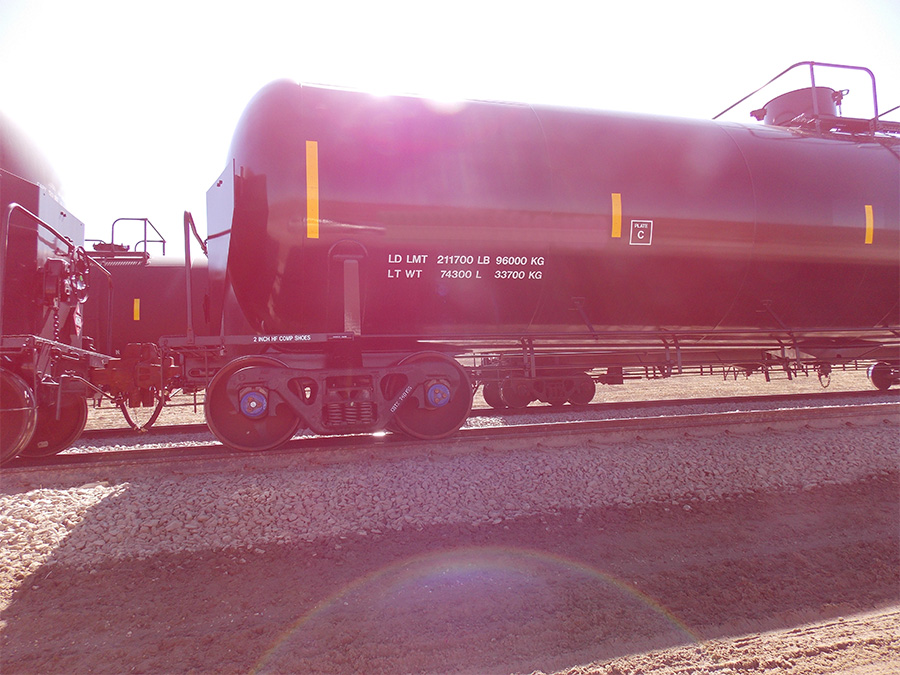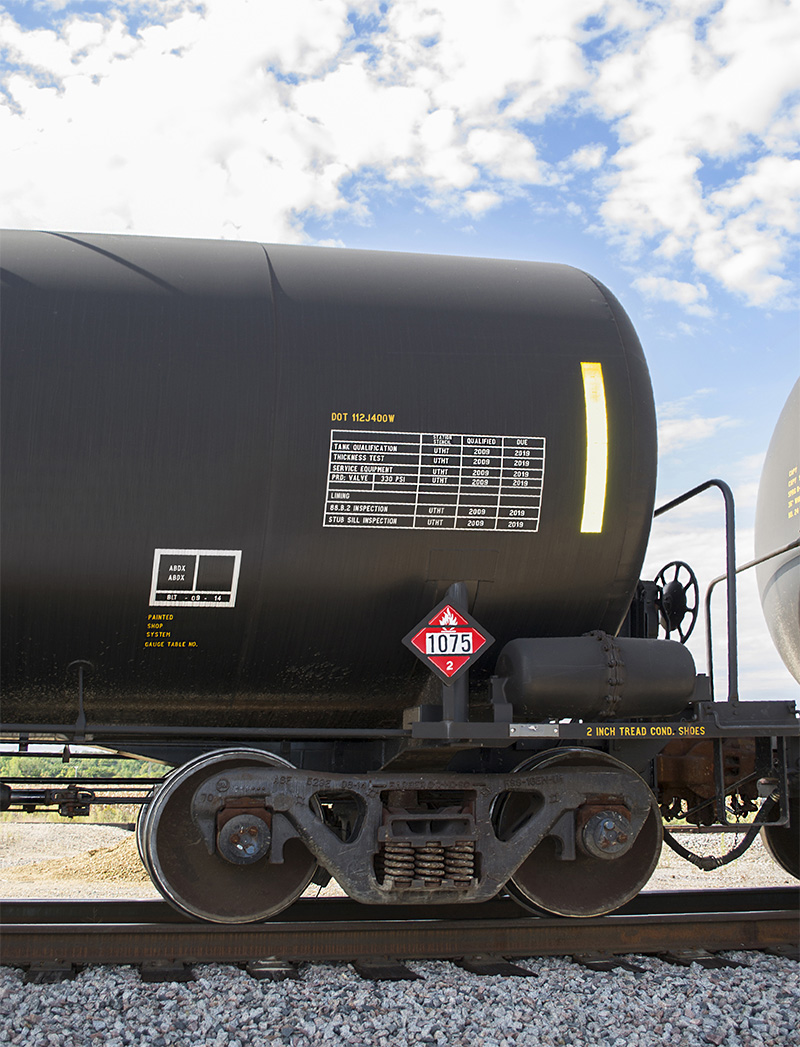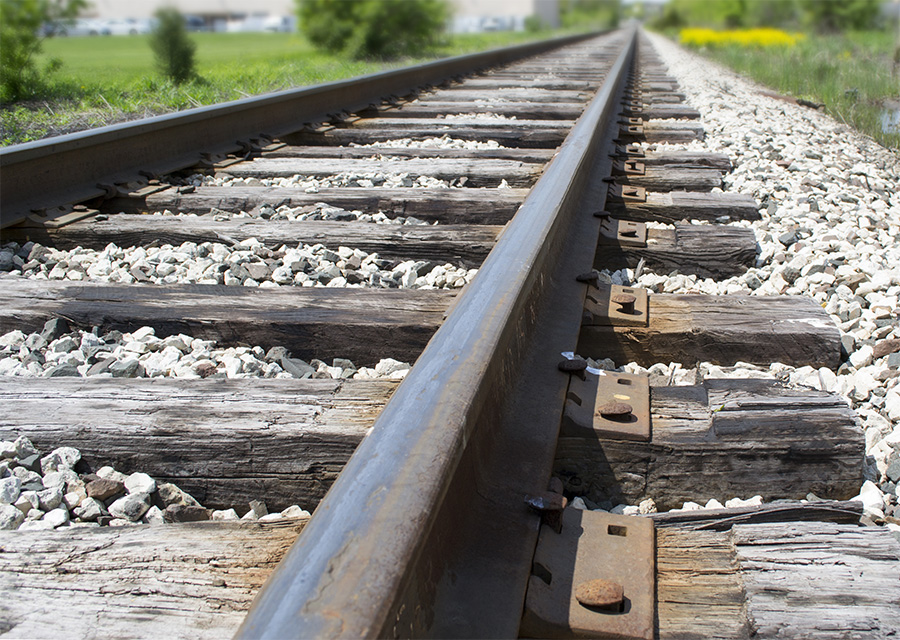Perplexing Market, Tepid Mood
June 26, 2019
By David Nahass, Financial Editor for Railway Age
 |

elcome to the Railway Age 2019 Guide to Equipment Leasing. The market for railcars continues to polarize, perplex and flummox investors, manufacturers and operators of both tank and general freight railcars. The tepid mood at Rail Equipment Finance in March 2019 has continued into a difficult spring that has been filled with flooding, service disruptions and system delays. The continuing evolution of PSR (Precision Scheduled Railroading) through the railroad system, along with general decreases in loadings for the calendar year to date, continues to put negative pressure on demand for railcars in the lease markets. Tank cars remain the brightest spot in the market right now.
Manufacturing continues apace for the time being. Deliveries for 1Q2019 stayed in the 13,000-ish range, holding steady at about that level for five out of the previous six quarters. New orders were at their lowest number since 4Q2014. Prices for new cars, especially for tank cars, on the heels of increases in steel costs and some momentum (real or otherwise) remain high. The new railcar delivery backlog sits at a robust 73,000 cars (vs. a 1Q2018 low of 53,000) with nearly half of that backlog representing tank cars (easily the biggest star in the railcar galaxy). Rumor on the street is that the order backlog extends into 2Q2020 for certain types of tank cars.
As owners, end users and operators navigate their way through a challenging lease market, many of these same parties have been dealing with a changing landscape of how the DOT and the AAR are approaching ongoing responsibilities of tank car maintenance. DOT/AAR is also changing the focus of their regulatory oversight over certain portions of the supply chain of railcar component parts (both new and replacement) vs. today’s standards.
On Oct. 24, 2018, the AAR issued Casualty Prevention Circular (CPC) 1338, which revises certain definitions and shop certification requirements contained within the AAR Manual of Standards and Recommended Practices, Section C, Part III, Specifications for Tank Cars. The proposed changes will significantly increase the number of facilities that require shop certification, including facilities that manufacture or maintain packaging components, and their certification requirements. The changes required under CPC-1338 come into effect Jan. 1, 2020. Our analysis, as follows:
CPC-1338 places restrictions on the types of subcontracted components, limits competition and increases operating costs without a clearly articulated safety benefit. As written, manufacturers of a tank car may only subcontract the fabrication of the tank shell, heads, nozzles and sump to their own design. There is no allowance for subcontracting for any other component.
CPC-1338 imposes requirements on parties involved in the manufacture of packaging components to go through a rigorous AAR certification program to be able to continue to supply components to the rail industry. Earlier standards required the tank car manufacturer/repair shop to verify the quality of the component prior to application to the tank car. The problem with the AAR certification process is that it imposes added quality requirements on manufacturers of components that are often different from their current quality programs (e.g., ISO-9001). Further, evidence suggests that the current AAR certification process may take more than 12 months to complete, with some companies experiencing longer delays (and sometimes accompanied by lost business).
CPC-1338 now requires AAR approval to change one manufacturer’s valve or fitting on a tank car with another manufacturer’s valve or fitting on a tank car having the same form, fit and function (i.e., equivalent kind, for example, a change of a 1-inch ball valve from one manufacturer to another). The earlier standards recognized that “equivalent kind” was not an “identical kind,” and therefore, such changes only required simple documentation of the change (i.e., documented in the industry’s Tank Car Integrated Database). The new standard requires AAR approval of the change, which can lead to significant delays in processing, and prevents usage of the car until the owner obtains approval.
 CPC-1338 will require certification of shipping locations that perform minor repairs to tank cars, such as fixing a broken chain or replacing a worn pipe plug. This will have a major impact on the shipping community, since repairs once made by plant operating personnel will now require the use of a certified mobile repair unit, moving the tank car to a shop or having the shipping location apply for and obtain an AAR shop certification.
CPC-1338 will require certification of shipping locations that perform minor repairs to tank cars, such as fixing a broken chain or replacing a worn pipe plug. This will have a major impact on the shipping community, since repairs once made by plant operating personnel will now require the use of a certified mobile repair unit, moving the tank car to a shop or having the shipping location apply for and obtain an AAR shop certification.
What is the goal of this AAR standard? On the surface, the goal is to support safer transport of hazardous materials by rail and to avoid non-accidental releases of product.
Below the surface, there can be many motivations: federal pressure, provincialism, concerns about potential failures. As noted on many occasions in “Financial Edge” columns, the history of the rail equipment industry as a self-policing progressive group has been a positive one. The AAR and its committees (Tank Car Committee, for example) that make policy and procedure recommendations on these issues are comprised of member companies and trade organizations that support them. These companies and associations are targets of product liability claims when an accident or incident occurs and in particular if there is a release of product. It is in everyone’s best interest to keep tank cars safely on the tracks—and when an accident occurs to ensure for the crashworthiness of the tank.
I reached out to Railway Supply Institute President Michael O’Malley and Greenbrier Vice President, Regulatory Services James Rader to talk about CPC-1338 and to get their points of view on the issues and on what RSI is doing to help its member companies address their concerns.
As a table setter, one big concern about CPC-1338 is the limitations on subcontracting and how those limitations impact the manufacture of packaging components. Under the federal regulations, the packaging manufacturer (i.e., tank builder) certifies that the completed tank (including its valves, fittings, closures and safety systems) complies with the regulations. CPC-1338 pushes the certification down the supply chain and in some cases to sub-suppliers (e.g., casting manufacturers that supply castings to manway cover manufacturers). By pushing additional requirements down the supply chain, CPC-1338 will increase the cost of production, reduce the flexibility to seek out new or additional suppliers, and will limit competition as traditional suppliers exit the market.
Specifically, the issues addressed by CPC-1338 are very relevant for cars built before 2014, when the rail industry began to move to the most up-to-date version of the crude-by-rail tank car, the DOT 117J design. Data from railcar shops indicates that as more tank cars are built (and that number has been increasing since 2011) more are shopped. The shop network is constrained as only tank car-certified shops are legally able to work on those cars.
The shop network is further stressed by the high turnover of the repair shop labor force. The market for tank car-specific components is similarly stressed by inventory concerns and with keeping up on the demand necessitated by all of the repairs being made to existing tank cars and with high-volume new production. Additionally, the increasing number of cars being retrofitted (in April 2019, almost 1,000 cars were retrofit to 117R status) adds more complexity to the situation.
In the midst of all of this, CPC-1338 comes into the picture. In speaking with O’Malley and Rader, it is clear from their perspective that the highest priority is the manner in which the rule limits the number of companies able to provide packaging components for replacement and for new manufacturing. In their analysis, the cost for a company getting certified to provide parts under the guidelines proposed by CPC-1338 will cost the packaging component supply chain more than $20.9 million over a 20-year period. Based on a survey of packaging component suppliers commissioned by RSI and completed by GRA & Associates, two-thirds of the current base of suppliers will either exit the market or consider exiting the market because of this new rule. Railcar parts are a small business segment for many manufacturers; the additional investment to be certified may never be recouped. Imagine if, in the next year or two, half of the component supply groups for tank car parts exit the supply base.
How did the DOT/AAR come to this conclusion? The DOT/AAR reviews the number of derailments and the likelihood or existence of conditional release of product from any derailment. Most large releases of product are from tank car punctures (car design and tank thickness) not componentry. In reviewing DOT’s product release data, there is no quantifiable data to suggest that additional AAR component supply chain requirements will improve safety. In fact, there is little, if any, incident data to support that poorly designed packaging components are a cause of concern.
RSI has proposed an alternative to the AAR standard. This recommendation, called RSI 100, “Product Quality Certification,” would authorize AAR-certified tank car manufacturers and repair shops to approve the part design and manufacturing processes of the third-party vendors providing those component parts. This would streamline the approval process, allow for a more cost-effective and efficient supply chain, standardize oversight and enhance component quality.
The goal of RSI 100 is to acknowledge the DOT/AAR agenda but with improved efficiency. RSI 100 would allow for faster and more cost-effective implementation. Regulation that may congest the system, limit competition and bring activity to a standstill is detrimental to the industry.
While RSI says it’s making progress with DOT/AAR on RSI 100, the problem has potential to become critical. There could be as many as 150 companies seeking certification. RSI and a group of lessors and manufactures see a critical need for resolution before the Jan. 1, 2020, AAR implementation date. Without resolution, suppliers asked to absorb the costs may decide to exit the component business altogether.
When asked about the other parts of CPC-1338, concerns about repair shop certification and the approval process for tank car repairs, O’Malley said RSI was advancing RSI 100 as a positive first step. The data on repair shops and the turn times in shops making tank car repairs is on an uphill climb. The tank car build cycle is leading to a period of time in the next few years where, with the number of tank cars needing scheduled maintenance and the 2023 equipment changeout for tank cars in ethanol service, shop capacity will likely be at a premium. This is combined with the already existent stress on the shop network for cleaning, retrofits, relining and repainting.
On the expanding scope of the AAR repair approval process, O’Malley and Rader noted that a federal change on this front, if not done in the manner associated with RSI 100 (a pre-emptive), would require a cost-benefit analysis to evaluate the potential alternatives and their benefits and improvements. The cost-benefit analysis is the standard procedure on federal policy matters. It was used, for example, in development of the FAST Act of 2015 and had implications on the decision to eliminate the ECP brake requirement from the original FAST Act requirement.
It is important for RSI 100 to demonstrate the DOT/AAR’s ability to work collaboratively with industry resources to improve policies and procedures that are working to make the industry safer. On matters relating to safety and car design, the industry track record has been collective, responsible and forward-thinking. DOT/AAR should work with the companies involved in the process to enhance and improve the process for repair and improvement.

Around the Market
As noted in the opening, the railcar market is frustrating and confusing, and remains weaker than investors would like it to be. Many were hopeful that 2019 would be a year of the turnaround, but halfway through, the turnaround in many car types continues to be out of reach. There are too many cars, too little demand and too many players chasing the same opportunities. PSR continues to affect car supply negatively, at least for now. It’s a pretty tough environment for railcar owners. Here’s a brief summary of what is happening in a variety of freight car types:
Coal Cars: Even though coal loadings are down 4.3% year-to-date, the coal car market seems to have found a semblance of stability. Some rates have begun to creep up, and newer cars (those built post-2004) are becoming slightly harder to find. Car owners should not count on continued improvement, as the demand cycle for coal is not trending upward. Net rates continue to trend in the low $100s on gondolas and rapid discharge hoppers, while full-service rates move around, depending on service and utilization. Freight continues to be an issue for cars in storage.
Sand Covered Hoppers: Owners must feel like abandoned souls waiting to be ferried to their final resting place across the River Styx. The impact of growth in more local (and lower cost) brown sand combined with the overbuilding in this segment has put these rates to the mat for the foreseeable future. Sand companies are again restructuring debt and looking to decrease expenses. Luckily, the industry seems to have stopped building more cars. If owners can find a lease opportunity, the rates are low, near $200 net and squarely below $300 FS (full service). For cars in place (renewals), rates might be higher. This is a lessee-favorable market right now. Long on this asset class? Hold on—it’s going to be a bumpy ride.
Tank Cars: These shine as the brightest light in a dim galaxy. With the order book for tanks into 2020, inventory is key, and cars seem to be renewing into rate strength for the car owner. Having said that, new tank railcars continue to be leased at rates that are sub-optimal vs. their purchase prices. The order book seems to be slowing, and the Alberta (Canada) provincial government has sworn it would exit the previous administration’s crude oil car deal. There is a sense of weakness here. Refined products into Mexico may be the only continued strong growth segment. However, the U.S. Class I’s continue to push against using 117R cars (or maybe they’re not, as it changes day to day and customer to customer), and that sows some uncertainty in the market for DOT 111A cars, whether they were built to the CPC-1232 standard or not. Rates range from the high $700s FS for smaller-capacity 23,000- and 25,000-gallon cars, 117J design) to the low $1,100s for crude oil tanks (ready to go right now). Pressure cars are a bit tighter, with rates closer to (or slightly above) $1,000 per car per month, FS.
Grain Covered Hoppers: This continues to be a tough market for investors as newer cars coming on the market (possibly through railroad purchase) continue to stress rates on investor-owned equipment. Early rate pickup in smaller-cube cars (4,750cf) was a nice change for investors seeing weakness, but expectations are that this will not continue for the long term. Rates on smaller cars are in the mid $200s FS, and on 5,200cf cars rates are holding in high $200s to $300. Inventory seems long, so expectations for increasing rates should be tempered.
Mill Gondolas: Steel tariffs did increase mill capacity (operating in the low 80% range), but they haven’t done anything for the scrap industry as June scrap rates are heading down to the $260 per ton for Chicago heavy melt #1. The PSR impact on mill gon lease rates seems to have found its footing. Car rates have come down into the low $400s for 54-foot mill gons, while 66-foot cars continue to sit in the mid $500s (FS for both). Summer is usually weak for scrap rates, so hopes rest for a resurgent fall. Check back in September for the Railway Age Railroad Financial Desk Book to see what happens. Talk about a cliffhanger!
Coil Cars (Finished Steel): The mill rates have helped stabilize these car types and generate some additional interest in new building. Rates are in the mid $600s for newer cars, but older cars can be had in the mid $400s per car per month, FS. There’s lots of variety in cover type and condition impacting rates.
Everything Else: A rush in centerbeam flatcars seems to have slowed slightly. While a 286K GRL riser-less car remains in demand, sub-optimal cars remain sidelined. Boxcars continue to move sideways with small pockets of TTX-generated building. The aggregate car market seems to have cooled slightly without direction from Washington on infrastructure and aggressive rate offerings on new and existing cars. Rates are in the low $400s.
David Nahass, Financial Editor for Railway Age
